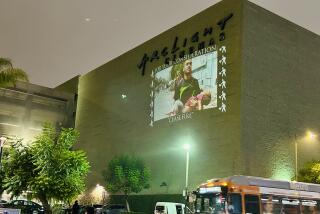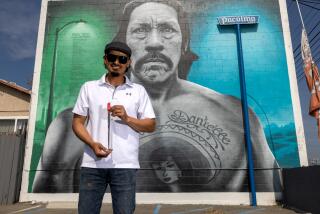NEA to Investigate Use of Funds for Bench Ads : Art: The agency says money may not be used for commercial advertising. The artists maintain their bus-bench ads are not selling anything.
- Share via
The National Endowment for the Arts will investigate four San Diego artists who used federal grant money to rent commercial advertising space on 25 bus benches as a protest against police use of deadly force.
NEA funds may not be used for commercial advertising, whether the content is political or not, Jack Lichtenstein, the arts funding agency’s national spokesman, said Thursday night from Washington. He confirmed that the NEA would “look into the matter” at the request of Rep. Bill Lowery (R-San Diego).
“Our general counsel, Julie Davis, and our inspector general, Leon Lily, are trying to determine the facts in the matter,” Lichtenstein said.
The bus-bench ads, which feature the artists’ work, began appearing in San Diego early this week. They protest shootings by police that have left nine people dead and 14 wounded since January. The artists have also called for a stronger police review board.
Lowery said he asked the NEA to investigate Thursday, noting that it was “highly unusual and improper for artists to take NEA money and buy commercial advertising, regardless of its content.”
The artists involved acknowledged using $3,662.50 of a $12,500 NEA to rent space on 25 area bus benches through Coast United Advertising of Commerce, Calif. Arlan Renfro, president of the company, said the check he received was from the account of Scott Kessler Public Relations. Kessler is one of the artists who produced the work.
Reached at home Thursday night, Kessler argued that the bus-bench ads did not constitute commercial advertising, even though the funds were paid to a commercial enterprise.
“We’re not advertising to sell a commodity. . . . We’re not selling a commodity,” Kessler said.
If it is commercial advertising, he argued, this is not the first time NEA funds have been used for such a purpose. The same group of artists used previous NEA grant money to buy ads that appeared on the back of San Diego Transit buses around the time of Super Bowl XXII in 1988.
That particular piece targeted the subservient role minorities play in promoting “America’s Finest Tourist Plantation,” which was the title of the piece on the back of the buses, Kessler said.
Even on this occasion, “that’s how the (current) grant was written,” he added--for the dissemination of social-protest art. He said the NEA knew such funds would be used to rent space on commercial billboards as a way of “making sure the art was seen.”
“I don’t understand what Lowery’s talking about,” Kessler said. “Think of all the money the police pay out in wrongful-death suits. Hey, that’s taxpayer’s money. This is just a herring. These people don’t want to talk about the real issue, which is this deadly policy of the San Diego Police Department.
“Lowery should be concerned about the people constantly dying at the hands of overzealous police. He should be more worried about the tax money spent in those wrongful-death suits than in preventing a couple of thousand bucks being spent to keep a few more people from dying.”
Lowery said the NEA might have funded such projects in the past, only because it was then “not the closely monitored agency it happens to be now.”
“We should be hoping here for a full recovery of the $3,600-plus,” Lowery said. “With recent legislation, we’re making sure the scope of NEA applications is fully complied with. And we’ll continue to take a close look.”
NEA spokesman Lichtenstein said the agency would withhold judgment until “reviewing all the facts in the matter,” but added that, for “any grantee to purchase advertising to place ads of any type would seem to be a most inappropriate use of NEA funds. If these allegations are true, it would be highly irregular. But we’d prefer to wait before commenting fully.”
Such a misuse of funds could hurt the NEA, Lichtenstein said, at a time when it’s clearly an embattled agency.
“I won’t assume anything until I’ve heard all the facts,” he added, “but such a thing does not serve the arts endowment--or the arts community--well at all. Even the perception of impropriety is, for us, a problem.”
The art on the 25 benches features the outline of seven human bodies silhouetted in black against a red background. Within each figure is a target, similar to those at police shooting ranges.
Within one target is a trowel, within another a baseball bat and within a third a garden stake. A pair of upraised hands and a question mark are drawn within others. Among those killed in so-called deadly-force shootings were men wielding a baseball bat, a garden stake and a trowel. Another man was unarmed.
In recent days, two of the 25 benches--those closest to San Diego police headquarters at 1401 Broadway--have been defaced in ways the artists say are “pro-police.” One bench now bears graffiti--”Kops Are OK”--and drawn in on another are the names and badges of two police officers killed in the line of duty.
Deborah Small, another of the artists, said the ads are not advertising, at least in the conventional sense.
“We have no product and nothing to advertise,” she said. “We’re talking about police practices and the fact that the City Council has abdicated its responsibility in overseeing the Police Department.”
More to Read
The biggest entertainment stories
Get our big stories about Hollywood, film, television, music, arts, culture and more right in your inbox as soon as they publish.
You may occasionally receive promotional content from the Los Angeles Times.










